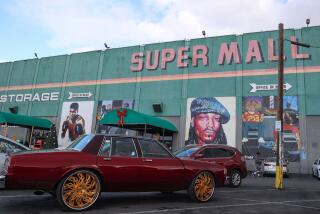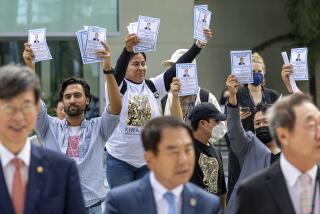Discord Rises Over Tours for Harmony
KOSUNG, North Korea — From behind ice-fogged windows, a busload of South Korean tourists stares in amazement at a scene of impoverished village life.
Children glide over a frozen pond on crude skates made from blocks of wood. An oxcart lumbers slowly down an unpaved road. Young soldiers stand stoically on the roadside trying not to shiver in thin army jackets cinched tight around wasp-slender waists.
The tour guide apologizes through the microphone. No, they are not allowed off the bus to talk to the North Korean villagers. No, they cannot take photographs, and in fact the curtains of the bus are tied back to discourage the tourists from concealing a camera beneath the folds.
“It is so frustrating. I feel a pain seeing those people living in poverty. I see the children and I want to cry. But we can’t talk to them, we can’t do anything to help,” said one of the tourists, Park Joung Ja, a 35-year-old secretary.
Three years ago, a bold venture was launched to bring South Koreans to the north for the first time in half a century. The idea behind the cruises to Mt. Kumgang, a breathtaking peak on North Korea’s eastern coast, was that tourism could foster a gradual reconciliation between the estranged Koreas.
But bringing tourists to this isolated country has proved even more difficult than expected, and the project looks as if it could go down in history as a failed, if noble, experiment. Hyundai, the South Korean conglomerate that runs the tours, is threatening to cancel the project next month if business doesn’t improve.
About 430,000 South Koreans have visited North Korea under the tours since 1998, an impressive number but well short of the 500,000 a year projected at the outset. The declining interest coincides with a stalemate in the rapprochement between North and South Korea. The giddy optimism that followed South Korean President Kim Dae Jung’s landmark visit to North Korea last year has given way to impatience and frustration.
Negotiations over economic cooperation and reunions of separated families have broken off. Kim’s “sunshine policy” of reconciliation is coming under harsh criticism from conservative political opponents.
“The pace of tourism depends on diplomatic relations, and relations right now are frozen,” said Jang Whan Bin, a director of Hyundai Asan, the subsidiary sponsoring the tourism project.
North Korea has balked at fulfilling a promise to open a land route through the demilitarized zone separating the north and south. As a result, tourists have to take an expensive and circuitous journey by boat to reach Mt. Kumgang. The North Koreans also have turned down repeated requests to allow tourists inside their villages, and have erected concrete barriers to make it more difficult for visitors to peer in at them from the tour buses. Many tourists bristle at myriad regulations and restrictions. Among the items banned on the trips are cameras with telephoto lenses, binoculars, books with any political content and South Korean currency.
Tour’s Finances Are a Source of Contention
The tours that were designed to promote reconciliation have become a source of contention.
North Korea, whose beleaguered Communist regime badly needs hard currency, is angry that cash-strapped Hyundai hasn’t paid up on more than $24 million in fees.
The South Korean national tourism organization pumped $35 million into the Kumgang project over the summer, a move that angered South Korean conservatives, who say taxpayer money shouldn’t be squandered on a nonviable project that is propping up Pyongyang.
With fewer than 2,000 tourists a month now signed up, Hyundai has cut its cruise schedule to less than a boat a week, and it might suspend the tours indefinitely if there aren’t more bookings.
The boats depart at noon from the South Korean port of Sokcho and sail for Kosung, a North Korean port 35 miles away. But because the North Koreans don’t want their coastline watched, the boat must head out toward Japan into international waters and then double back, dragging what would otherwise be a one-hour jaunt into five hours.
To pass the time, Hyundai shows the tourists a chilling film warning of the rules of the game. They are forbidden to photograph any North Koreans, to try to give them money or letters or to discuss any topic related to politics. (It’s OK to photograph the mountain but not the coastline). While hiking on Mt. Kumgang, they are not allowed to spit, smoke, urinate, or pick up flowers or pebbles because of strict North Korean environmental protection regulations. (In the next breath, the Hyundai guide warns the tourists not to comment on the obvious irony: There are huge inscriptions on the rocks of Mt. Kumgang extolling North Korea’s late “Great Leader” Kim Il Sung.)
“You are meeting your brothers for the first time in 50 years, so make sure you don’t criticize their way of living,” warns a Hyundai guide, 22-year-old Kim Kang Kyung.
In fact, the South Koreans barely set foot in North Korea. Most of the tourists sleep in a floating hotel and eat in a compound surrounded by barbed-wire fences. The commercialized atmosphere is straight out of South Korea; the tourists are greeted upon arrival by Hyundai employees dressed in bear costumes and by a Filipino band belting out “California Dreaming,” an oddity in this dark, wind-whipped port where temperatures were hovering around zero.
The only chance to mingle comes on the hiking trails, where half a dozen North Korean guards watch over the tourists. Among the North Koreans, who wear drab polyester winter coats and black boots, the South Koreans look like exotic tropical birds, with expensive and bright-colored hiking gear in Gortex and fleece. Per-capita income in South Korea is 12 times greater than in the north, according to a recent report, and it is patently obvious by the clothing.
The North Korean guards pepper the tourists with questions about politics and economics. They want to know who will win elections next year in South Korea; where South Koreans go on vacation; and how much apartments cost these days in Seoul. The Northerners cluck their tongues sympathetically when a young clerk tells them he will have to work seven years to afford an apartment.
Brief Meetings Frustrate South Koreans
But these brief encounters leave the South Koreans depressed and frustrated.
“I wanted to give these guards some money. I even had my hand on some dollars wadded up in my pocket. But I saw too many people watching--these guards watch each other, not just us,” said Kim Choon Kap, a 39-year-old military recruiter.
Like many of the South Korean tourists, Kim came away from the tour believing that reunification, if it happens, will take longer than expected.
Several tourists who grew up in the countryside commented on the thinness of the rice crops and on the mountainsides left barren after trees were cut down for fuel. Even through the windows of the tour bus, they noticed that the oxcart had no tires, only primitive metal wheels; and that there was no sign of running water, no cars other than an occasional army jeep and virtually no electricity at night.
“I used to think what I heard about North Korea was exaggerated, but now I think it is worse than I thought. They look very poor, very isolated,” said Kim, glumly nursing a beer on the boat ride back home after the three-day trip.
Park Chan Mo, a 71-year-old retired teacher, said that the glimpse of North Korea he got on the trip reminded him of South Korea at the end of the devastating 1950-1953 Korean War.
“I had heard that the way they live is like the 1960s, but it is like the 1950s. There is a gap of half a century between us. The gap is so dramatic I fear we will not be able to unite any time soon,” Park said.
On the boat ride home, some of the tourists clutched small stones they had picked up in defiance of the rules--as if they were chunks of a Berlin Wall that could someday symbolize the tearing down of barriers between people.
More to Read
Sign up for The Wild
We’ll help you find the best places to hike, bike and run, as well as the perfect silent spots for meditation and yoga.
You may occasionally receive promotional content from the Los Angeles Times.






